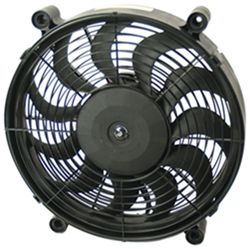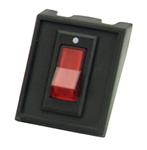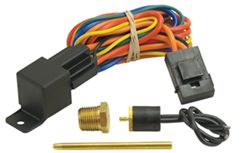
Electric Radiator Fans
Works great in stop-and-go traffic and towing applications Supplies airflow regardless of RPM Reduces load on engine and increases fuel economy and horsepower

Fan Controls
Gives you absolute control - you can turn the fan on or off with the flip of a switch Turn it off to save power Turn it on in heavy traffic to ensure proper airflow

Fluid temperatures determine when fan turns on or off Thermostat is threaded or pushed into the radiator core to read fluid temperature A signal is sent to engage the fan at a set temperature, and another goes out to disengage when fluid drops to a more appropriate temperature
Sufficient airflow is available regardless of your vehicle's RPM All the work is done automatically - no worries about forgetting to turn the fan on or off

Airflow Requirements
If your vehicle is often used for towing, you will most likely need additional airflow. And if your engine has been modified by raising the compression ratio or installing a turbocharger, for example, you will need more CFM. In cases like those, you will have to estimate how much more power might be needed for your individual vehicle. If you're unsure about how much you need, go with the highest-rated fan or fans. And remember, there is no limit to the number of fans you can install, as long they all fit appropriately and are mounted on the same side of your radiator so that they do not cancel each other out.
Types of Electric Fans
Pulls air through the radiator for maximum efficiency Mounts between the engine and the radiator
Pushes air through the radiator Mounts between the radiator and grille
Departments
Towing
- Trailer Hitch
- Fifth Wheel
- Gooseneck
- Towing a Vehicle
- Front Hitch
- RV Hitch
- ATV Hitch
- HD Truck Hitch
- Vehicle Wiring
- Brake Controller
- Ball Mounts
- Weight Distribution
Sports and Recreation
Trailer Parts
- Utility Trailer
- Boat Trailer
- Landscape Trailer
- Enclosed Trailer
- 5th/Camper Trailer
- Car Hauler
- Horse Trailer
Vehicle
Contact & Help

Popular Vehicles
- Subaru Forester
- Ford F-350 Super Duty
- Ford F-250 Super Duty
- Chevrolet Silverado 1500
- Jeep Wrangler Unlimited
- Jeep Wrangler
- Ram 3500
- Toyota Highlander
- Ram 2500
- Chevrolet Silverado 2500
- Subaru Outback Wagon
- Chevrolet Silverado
- Dodge Ram Pickup
- GMC Sierra 2500
- Ram 1500
- Ford F-250 and F-350 Super Duty
- Jeep Grand Cherokee
- Toyota Tacoma
- GMC Sierra 3500
- Toyota Tundra
- Ford Escape
- More >>

